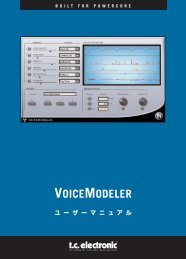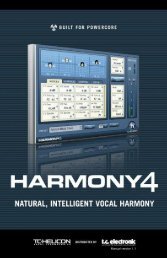Create successful ePaper yourself
Turn your PDF publications into a flip-book with our unique Google optimized e-Paper software.
.<br />
<strong>TC</strong>-<strong>Helicon</strong> <strong>Quintet</strong> MIDI System Exclusive<br />
Version 1.1<br />
Note: All numerical values will appear in HEXADECIMAL notation unless otherwise indicated:<br />
0xF0 = F0h = F0 – The latter value is the expression of the hex numeral used.<br />
Decimal equivalents will appear in brackets after their hex counterparts:<br />
0xF0 = F0h = F0 = (240)<br />
0x64 = 64h = 64 = (100)<br />
General message format:<br />
F0<br />
MIDI System exclusive message start<br />
00 3 byte manufactors ID for <strong>TC</strong>-<strong>Helicon</strong><br />
01 ...<br />
38 ...<br />
<br />
System exclusive device ID (user parameter)<br />
4D<br />
<strong>Quintet</strong> model ID<br />
<br />
<strong>Quintet</strong> message type identifier (see table below)<br />
<br />
Data – depends on message type (see format description.<br />
below)<br />
…<br />
…<br />
F7<br />
MIDI System exclusive message terminator<br />
Preset numbers<br />
Preset numbers are represented in the SysEx messages as 1 byte.<br />
Preset number zero is the currently edited preset, and 1 to 50 are as is.<br />
Message data format<br />
The format of the data used/needed in the different SysEx messages depends on the type of<br />
message. Below are descriptions for each message type explaining data formatting.<br />
SysEx message type<br />
Identifier<br />
<strong>Quintet</strong> Request Preset 17<br />
<strong>Quintet</strong> Request All Presets 16<br />
<strong>Quintet</strong> Preset Data Package 18<br />
All CCs Request 32<br />
<strong>TC</strong>-<strong>Helicon</strong> Vocal Technologies<br />
www.tc-helicon.com<br />
Page 1
<strong>Quintet</strong> Data Request messages<br />
Preset Request - 17:<br />
is 1 byte representing the number of the preset requested. The data transmitted by<br />
<strong>Quintet</strong> upon receiving this message will be formatted as a Preset Data message (see below for<br />
complete description)<br />
All Presets Dump Request - 16:<br />
is 1 byte and should be set to 0. Upon receiving this message, the <strong>Quintet</strong> will dump all<br />
50 presets as consecutive individual Preset Data messages.<br />
All CCs Request - 32:<br />
is 1 byte and should be set to 0. Upon receiving this message, the <strong>Quintet</strong> will send out<br />
all of its CC values to reflect the state of the unit. The <strong>Quintet</strong> CC specification can be found in<br />
the <strong>Quintet</strong> <strong>Manual</strong>.<br />
<strong>Quintet</strong> Data messages<br />
Preset Data Package - 18:<br />
is 15 bytes organized as follows (in sequence):<br />
1 byte Preset number<br />
1 byte Normal Button Bitfield<br />
1 byte Alternate Button Bitfield<br />
1 byte Alternate Root<br />
1 byte Alternate Scale Type<br />
1 byte Harmony Mode<br />
1 byte Harmony Root<br />
1 byte Harmony Type<br />
1 byte Harmony Smoothing<br />
1 byte Harmony Tuning Type<br />
1 byte Harmony Latch<br />
1 byte Lead Level<br />
1 byte Harmony Level<br />
1 byte Effects Level<br />
1 byte Reverb Type<br />
Button Bitfields<br />
<strong>Quintet</strong> allows the user to set harmony voicing using the six voicing buttons on the front panel.<br />
They are called from left to right: BASS, LOWER, LOW, UNISON, ABOVE, TOP<br />
The button bitfield byte is made up of bits as follows:<br />
0gfedcba (only 7 bits used in a MIDI byte)<br />
a = BASS Enabled<br />
b = LOWER Enabled<br />
c = LOW Enabled<br />
d = UNISON Enabled<br />
e = ABOVE Enabled<br />
f = TOP Enabled<br />
g = Don’t Care<br />
<strong>TC</strong>-<strong>Helicon</strong> Vocal Technologies<br />
www.tc-helicon.com<br />
Page 2
Using a footpedal, <strong>Quintet</strong> allows for an alternate preset setting which gives the user a separate<br />
button voicing configuration, a alternate scale root, and an alternate scale type (only available in<br />
scale mode presets). Alternate settings are stored in the alternate fields of the Preset Data<br />
Package as seen above.<br />
<strong>TC</strong>-<strong>Helicon</strong> Vocal Technologies<br />
www.tc-helicon.com<br />
Page 3



